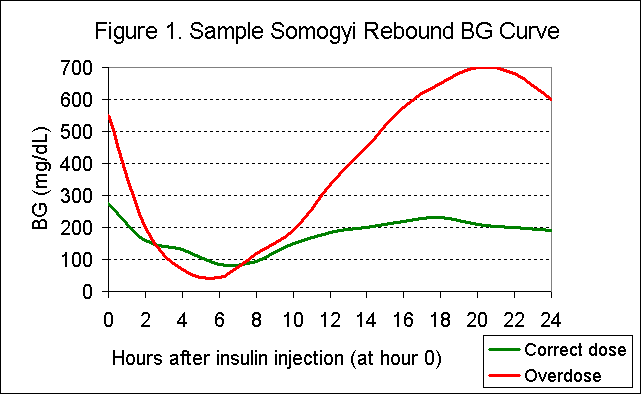|
|
Definition
Somogyi rebound is one of the body's natural defense mechanisms to protect itself against hypoglycemia.
It can occur when the blood glucose is too low, or if the blood glucose is
above "normal" but drops too quickly.
A non-diabetic maintains normal sugar metabolism using two major hormones. The first is
insulin, which lowers the blood glucose by allowing cells to remove
glucose from the blood and either use or store the glucose. The second hormone
used to regulate sugar metabolism is glucagon. Like
insulin, glucagon is produced by the pancreas. Glucagon has the opposite effect of
insulin. Glucagon causes cells to release glucose, thus causing the blood glucose to
increase.
When the blood glucose becomes too low, the body's natural defense
mechanism is to release glucagon and several other hormones into the blood. The overall effect
of these hormones is to increase the blood glucose. Glucagon causes the liver to rapidly
release large amounts of stored glucose into the blood stream. After all
this glucose is released into the blood, the animal can become hyperglycemic (high blood glucose). The other
hormones involved in this protective mechanism act to keep the blood glucose elevated for
a longer period of time.
Because Somogyi involves several other hormones that have a longer duration of action than
glucagon, the hyperglycemia caused by a Somogyi may last for several days
and you may see insulin resistance. This can make diagnosing somogyi
difficult.
Somogyi bg curve
Figure 1 shows a hypothetical Somogyi rebound. The green line show the
bg curve when an appropriate insulin dose is given and the red line shows the Somogyi
rebound that can occur when too much insulin is given. Thanks to Brenda and Cody for
data for this graph.
When
does a Somogyi Rebound happen?
If an animal experiences hypoglycemia,
or if the blood glucose drops drops too quickly, the body tries to protect itself
using the Somogyi response and the
result is elevated blood glucose, or hyperglycemia.
A Somogyi rebound is not always triggered. Whether it happens at all, how low the blood
glucose must go, or how fast the blood glucose must fall to trigger a rebound is
individual to each animal. The bg does not need to be dangerously low for a
Somogyi rebound to be triggered. Rebounds can occur when the blood glucose is in
"safe" levels, say around 120 mg/dL, but the bg is dropping very
rapidly. For example, if the blood
glucose drops very rapidly from the 400s to the low 100s in a relatively short
time, the
animal is never hypoglycemic (the blood glucose stayed above 100), but the body
senses danger in the rapidly falling blood glucose, and the Somogyi rebound can be
triggered.
When to suspect Somogyi
rebound
If you are monitoring urine glucose, Somogyi rebound is suspected
when the morning urine is persistently high. It can also be suspected when the morning
urine glucose is high, the afternoon urine glucose is "negative" and the evening
urine glucose is high.
Somogyi is also suspected when symptoms such as excessive urination, excessive drinking,
symptoms of hypoglycemia, and weight loss continue, even as the insulin dose is increased.
Before a rebound, the period of hypoglycemia may be short and you may not notice the
symptoms of hypoglycemia. That's the point of the rebound - to avoid further hypoglycemia.
Somogyi can be diagnosed when you get blood glucose levels below
65mg/mL followed by hyperglycemia (typically >300 mg/dL) within one 24-hour period
after an insulin injection.
During the course of diabetes management, if you continue to see no improvement in your pet's
condition even after increasing the
insulin dose, please ask your vet about the possibility of Somogyi rebound.
Also, if you are having difficulty getting your pet regulated or are getting
very strange bg curve results, you might suspect Somogyi. It is not
uncommon to go past the correct insulin dose and get into a rebound
situation and many owners have found that their difficulty in achieving
regulation is due to chronic insulin overdosing and rebounding.
Treatment
The treatment for Somogyi rebound is to DECREASE the insulin dose.
Since the
current insulin dose is too high and is causing a rebound hyperglycemia, treatment is to DECREASE the insulin dose to a level where the blood glucose will not drop so low.
If the rebound is being triggered by blood glucose that is falling too
rapidly, you may need to decrease the dose, change the feeding and injection
timing, or try an insulin that has a more gradual onset.
Is Somogyi A Common
Occurrence?
Many pet owners are told that Somogyi is a rare event, but that seems to be
based on information from human diabetics.
From talking with owners of diabetic pets,
Somogyi rebound is not uncommon, and many pets have experienced Somogyi
rebound. This makes sense
because humans are able to test their bg frequently and they can sense the
physical signs of their low bg and do something (eat) to prevent a severe hypo / rebound
situation. Since we usually can't monitor our pets that closely and they can't
tell us their bg is low, it is not uncommon for pets to get into
Somogyi rebound situations.
Other terms
Because Somogyi can be caused by too much insulin or hypoglycemia, Somogyi rebound is also called
insulin-induced hyperglycemia, or
hypoglycemia-induced hyperglycemia. Somogyi is the last name of the researcher who
identified this phenomenon.
This is one of the more complicated issues when caring for a diabetic pet. Please discuss
Somogyi rebound with your vet. Your vet will be able to explain it to you and determine if
your pet is experiencing a rebound.
 




Updated October 2000
Copyright. All rights reserved.
This site is for information purposes only. Please consult
your veterinarian. |
 Somogyi Rebound
Somogyi Rebound Somogyi Rebound
Somogyi Rebound